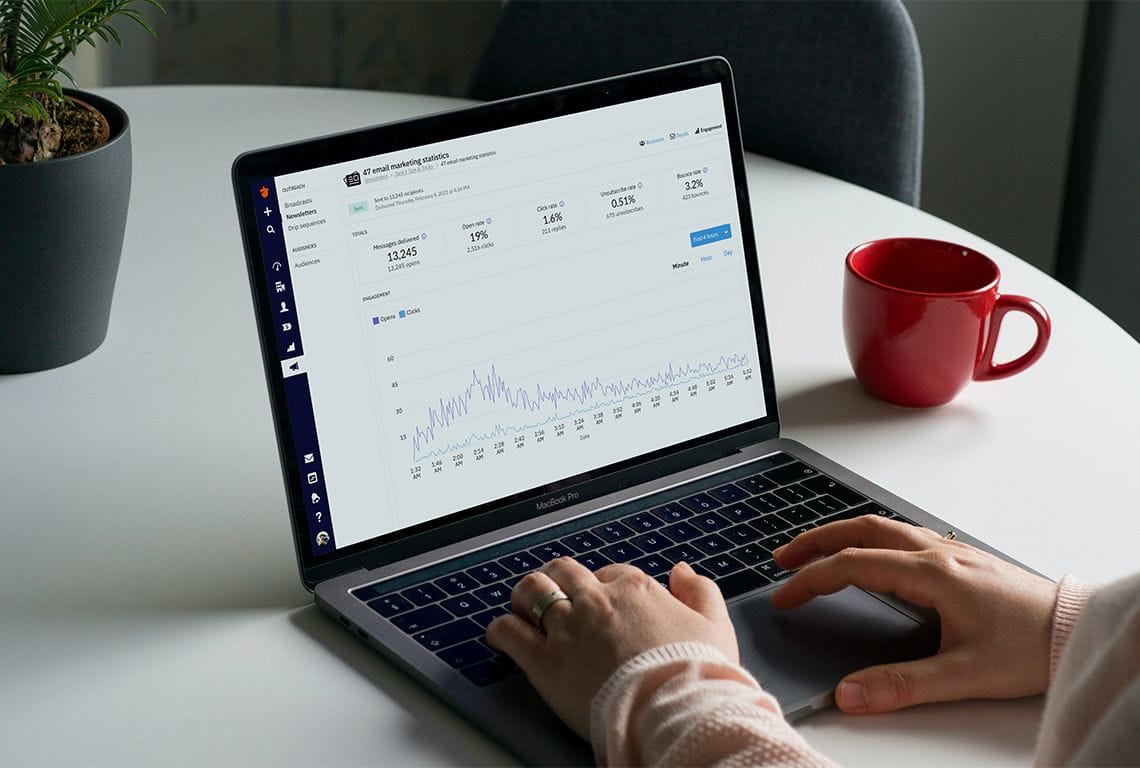Want to partner with an expert email marketing agency?
Invest in professional email marketing services from WebFX to increase revenue and kick your company’s growth into high gear.

As new marketing channels like social media, influencer marketing, and chatbots have risen in popularity over the years, email marketing has remained one of the most popular and effective marketing strategies available.
Of all the trends that come and go, email marketing isn’t one of them.
That’s why we put together this list of 40+ email marketing statistics. Whether you want to see the numbers on email marketing’s effectiveness, get the scoop on how to increase your email click-through rate, or explore benchmarks for your industry, we’ve got what you need!
Just keep reading for the latest email marketing stats.
Email marketing remains one of the most effective digital strategies, offering high ROI, widespread reach, and strong engagement metrics. Personalization, mobile optimization, and CRM integration significantly boost open and click-through rates, making targeted campaigns more impactful.
Email marketing is promoting your brand, products, or services to potential and current customers via email. Email marketing can include sending regular email newsletters, one-off email campaigns, and automated emails that are, for example, triggered by audience actions on your website or sent on a specific schedule.
Email marketing enables you to regularly interact with leads and customers so that you can nurture your relationships with them over time. You can send emails to large groups of people all at once while maintaining a more personal, one-on-one feel. You can also personalize emails to individuals or groups of recipients and use automation to increase efficiency.
These statistics are relevant for almost all email marketers. Understanding these statistics can help you better understand the industry, and more importantly, how to make your own email marketing even better.
The B2B Marketer’s Toolkit collects 120+ of the best lead generation tips ever published on the Nutshell blog. Download it today!

From when to send emails to writing the perfect subject line and using personalization, these email marketing stats will give you insights into how to improve your email campaigns’ effectiveness.
Did you know that depending on the demographics of the person reading your email, they’ll react differently?
Before sending out your email campaign, keep the demographic of your audience top of mind.
No matter if your email is reminding customers of a cart they abandoned, telling them about a sale your business is running, or sharing news about a new product, chances are good that readers will open that email on their smartphone. Make sure your email is mobile-friendly with these statistics.
Invest in professional email marketing services from WebFX to increase revenue and kick your company’s growth into high gear.

Follow the best practices below to optimize the results you see from your email marketing campaigns:
Your email subscribers have unique backgrounds, demographics, experiences, expectations, and preferences. Truly successful email marketers don’t “follow all the rules”—they figure out what works best for their subscribers and give them what they want.
To make the most of every email sent, you’ll need to think of your subscribers first, rather than thinking of what email marketing strategies other companies are using. Take the ideas you see and customize them to fit your audience.
So, how do you know if you’re giving your email recipients what they need? By testing your campaigns. Your recipients will show you what works best through their email engagement.
It’s critical to A/B test your email messages to determine things like:
And at the end of the day, the statistics shared in this guide are just a starting point—it’s your job to determine what your email recipients really want from your brand.
You and your marketing team only have so much time in your week. As survey after survey has shown, using tools like automation and AI writing assistants not only works for email marketers, but it also works for recipients.
Subscribers enjoy a personalized email experience, whether it’s customized email content or a triggered email sequence custom-made for their needs and where they are in the customer journey. Make sure to utilize all the tools at your disposal to save time and give recipients a positive experience with your company.
A key component of improved email deliverability and campaign success is compliance with local and international data privacy laws. This involves implementing a few best practices, such as:
Start with the “big three”: open rate (shows subject line effectiveness), click-through rate (measures content engagement), and conversion rate (tracks actual results). These metrics tell you if people are opening your emails, engaging with content, and taking action. Once you’ve mastered these, add bounce rate and unsubscribe rate to monitor list health and audience satisfaction.
B2B emails typically see higher open rates (around 35-40%) but lower click rates (2-3%) compared to B2C. B2B buyers need more touchpoints and longer nurture sequences, while B2C audiences respond faster to promotional content. B2B conversion rates average 2.4% versus 2.8% for B2C. Your industry matters more than business model—compare yourself to similar companies, not just B2B or B2C averages.
Different sources use different sample sizes, industries, measurement periods, and calculation methods. Some platforms count unique opens while others count total opens. Industry mix matters too—a report heavy on retail will show different numbers than one focused on B2B tech. Use statistics as directional guidance, not absolute truth. Your own historical data is your best benchmark.
Compare your metrics to three benchmarks: your industry average, your own historical performance, and your business goals. A 25% open rate might be excellent for retail but poor for nonprofits. Focus on trends—are your numbers improving over time? Most importantly, track conversions and revenue. High engagement means nothing if you’re not achieving business objectives like sales or leads.
Yes, but expect more volatility. Small lists often show higher engagement rates (42%+ open rates are common) because they’re typically more targeted and personal. However, your metrics will fluctuate more dramatically—one unsubscribe from a 100-person list is 1%, versus 0.01% from a 10,000-person list. Focus on growth and engagement trends over 3-6 months rather than individual campaign performance.
Or at least, your customers do. If you want to get more from your email marketing, incorporate the lessons from these statistics into your email marketing strategy.
And, of course, be sure to check out our comprehensive guide to email marketing for inspiration and guidance on your own email marketing journey.
Looking for a solution that will help you manage email marketing, track prospects, and strategically strengthen customer relationships? Nutshell is the all-in-one email marketing and CRM platform that helps teams market and sell better. With a built-in email marketing tool, sales automation features, and pipeline management, Nutshell is the solution for generating more leads, nurturing them through the right channels, and converting them into customers. Start your 14-day free trial today!
Nutshell Email marketing plugs directly into your CRM data, so you can create highly targeted audience segments, track the impact of your emails in real-time, and manage all your communications out of a single tool. Get started for free!

Join 30,000+ other sales and marketing professionals. Subscribe to our Sell to Win newsletter!
